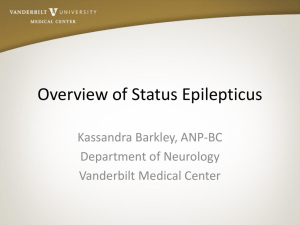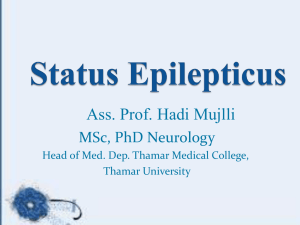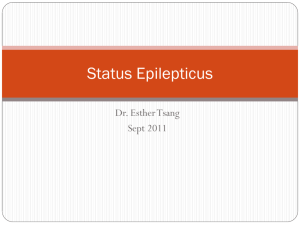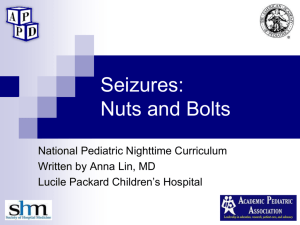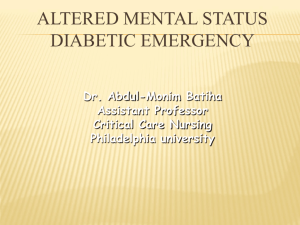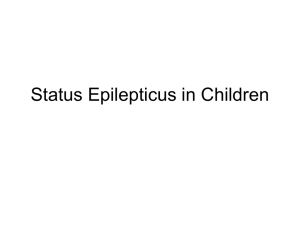se & eeg.pps
advertisement
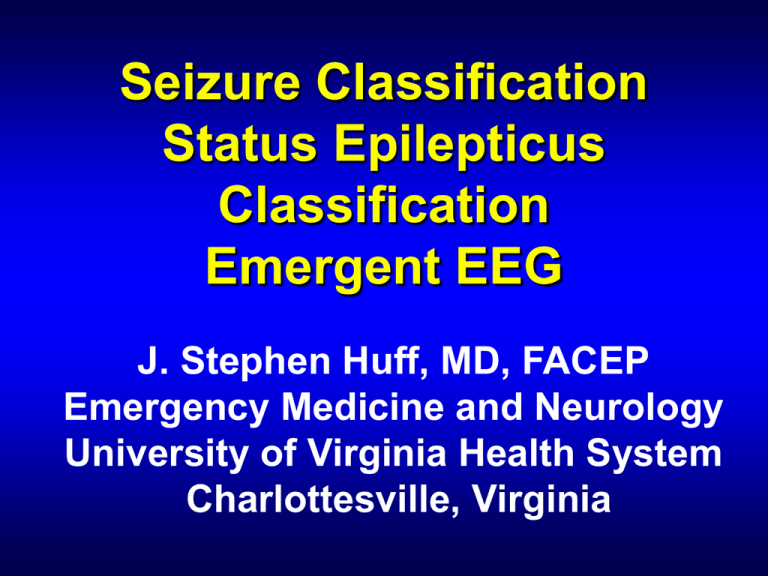
Seizure Classification Status Epilepticus Classification Emergent EEG J. Stephen Huff, MD, FACEP Emergency Medicine and Neurology University of Virginia Health System Charlottesville, Virginia Case Study A 72 year old woman is brought to the ED by EMS after having altered behavior and inability to speak. She was preparing for bed when peculiar behavior was noted. The patient is unable to speak and is having unusual jerking movements. Case Study (cont.) The patient has no history of seizures. There is a history of stroke two years previously with residual mild right sided hemiparesis. There is no history of trauma. The patient has a history of hypertension for which she takes a diuretic. Case Study (cont.) On physical exam, her vital signs are blood pressure 120/80, pulse 90, respiratory rate 14, temperature 99, pulse oximetry 98% saturated on supplemental oxygen. She appears alert, eyes open, but is unable to speak. She does look towards the examiner when asked questions. The right side of the patient’s face, torso, and right upper extremity are having a continuous rhythmic motion. Case Study (cont.) Cranial nerves appear intact with the exception of facial twitching. The patient does not follow commands. Deep tendon reflexes are difficult to obtain because of movements. Is this a seizure? What type? Status? Questions • • • • Is the patient having a seizure? What type? What is a classification of seizure types? What is status epilepticus and when is status epilepticus a medical emergency? When is an EEG indicated in the emergency department? Differential diagnosis of recurrent movements • • • • • • • • Repetitive abnormal posturing (extensor, flexor) Tetanus Neuroleptic malignant syndrome Rigors due to sepsis Myoclonic jerks Tremors Hemiballism / involuntary movements Nonepileptic (psychogenic) seizures Basic classification of seizure types • Partial or general? If partial – motor – sensory – special sensory – psychic • Modifiers for localization • Basic classification of seizure types Simple implies: – consciousness not impaired – simple motor seizure Complex implies: – consciousness impaired – complex partial seizure Basic classification of seizure types Generalized implies: – All areas of cortex involved – Consciousness impaired Convulsive implies: – Generalized motor activity – Tonic-clonic – Phasic Generalized seizures • Primarily generalized-all areas of cortex activated at once – Absence / petit mal – Myoclonic seizures • Secondarily generalized-one area of cortex activated then spreads Secondarily generalized seizures • • • Implies a focus of abnormality – Tumor – Old stroke Most common type of generalized seizures in adults Generalization often occurs too rapidly to appreciate at bedside Seizure description • • • • • Include any aura Include any initial motor manifestations Include description of tonic phase if present Include description of clonic phase Include level of consciousness Seizure description Our patient in video example: Partial motor status epilepticus with complex symptomatology What is status epilepticus? WHO - “enduring epileptic condition” Traditional definitions: – 30 minutes continuous seizures – Series of seizures without return to full consciousness between What is status epilepticus? • Simple status epilepticus (consciousness preserved): • simple motor status epilepticus • sensory status epilepticus • aphasic status epilepticus • Nonconvulsive status epilepticus (consciousness impaired; twilight or fugue): • petit mal status • complex partial status epilepticus What is status epilepticus? Part 2 • Overt generalized convulsive status epilepticus (continuous convulsive activity and intermittent convulsive activity without regaining full consciousness): – Convulsive (tonic-clonic) / tonic / clonic – Myoclonic • Subtle generalized convulsive status epilepticus (following generalized convulsive status epilepticus with or without motor activity) Types of status epilepticus As many types of status epilepticus as there are seizure types: – Generalized tonic-clonic status – Absence/petit mal status – Complex partial status Why is status an emergency? • Ongoing generalized status epilepticus • Potential for neuronal damage • Electrical activity alone is damaging Rationale for aggressive treatment in generalized convulsive status epilepticus 1. The longer generalized convulsive status epilepticus persists, the harder it is to control. 2. Neuronal damage is primarily caused by continuous excitatory activity, not systemic complications of generalized convulsive status epilepticus. 3. Systemic complications of seizure activity, particularly hyperpyrexia, may exacerbate damage. 4. Every seizure counts in terms of making generalized convulsive status epilepticus more difficult to control and for causing neuronal damage. Status epilepticus requiring immediate, aggressive treatment • Continuous generalized convulsive activity with impaired consciousness lasting greater than 5 min* • Serial seizures without return to full consciousness between seizures • SGCSE epilepticus - coma with minimal or no associated motor activity: • Consider if post-ictal state is not improving in 20 minutes* • May evolve from GSCSE Status epilepticus that possibly benefits from aggressive treatment • Evidence of CNS injury from these seizure types is not as clear…. • Complex partial status epilepticus (twilight or fugue state)† † EEG may be required for diagnosis Status Epilepticus Requiring Treatment (Not time critical) • Absence status epilepticus (spike-wave status epilepticus)† • Simple motor status epilepticus (epilepsia partialis continua)† † EEG may be required for diagnosis When is an EEG indicated in the ED? • • • • • • Persistent altered consciousness Refractory generalized convulsive status Pharmacologic paralysis Viral encephalitis Undifferentiated coma Brain death When is an EEG indicated in the ED? • Multicenter Study Emergency Medicine Seizure Study Group • EEG uncommonly used -local practice pattern? • When is an EEG indicated in the ED? Survey of EEG labs shows: – An average response time of 3 hrs – Neurology consulted first – No clear consensus existed When is an EEG indicated in the ED? • Most compelling scenario: •Generalized convulsive status epilepticus • Pharmacologic paralysis • Consideration of “subtle” status • Patient not awakening 20-30 minutes after seizure termination EEG Problems • Artifact / Interference • Complex interpretation • High inter-observer variability • Technician intense Normal Alpha Rythm EM Artifact Frontalis Muscle Artifact EKG Artifiact Triphasic Waves 3 cps Generalized Spike-wave during HV Right Anterior Temporal Seizure, Eye Movement End-stage Convulsive Status Epilepticus When is an EEG indicated in the ED? •Generalized convulsive status epilepticus • Pharmacologic paralysis • Consideration of “subtle” status • Patient not awakening 20-30 minutes after seizure termination • Pathway-early neurologic consultation Questions?
